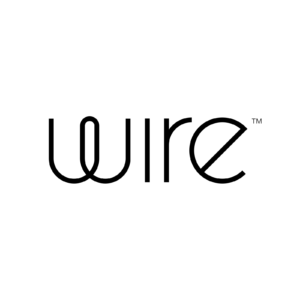Avoid Zoombombing with these alternative video conference apps.
What Are the Best Zoom Alternatives?
It feels like as a society, we’ve accepted Zoom to be the best video conferencing software out there. It’s kind of like how we all decided to dress like Avril Lavigne in the early 2000s. Turns out there’s plenty of Zoom alternatives out there that are more secure and offer more features. Kudos to all you people out there who haven’t had to delete your old MySpace pictures with your best Avril looks.
As a remote team, Reviews.org team uses Zoom for its video conferencing. But since we use Zoom, we know all the reasons why people start to consider alternatives. Thankfully, we haven’t been hacked mid-meeting, but we have had technical issues and have been suddenly kicked off meetings.
If you're a remote worker who has technical or security problems with Zoom, then this is the article for you.
- : Best free Zoom alternative
- : Best integration with GSuite
- : Best bundle of Microsoft Office programs
- : Most accessible
- : Most secure Zoom alternative

What’s so great about Zoom anyways?
Zoom has captured the moment and everyone (including us) seems to use it for video conferencing. Zoom’s biggest claim to fame is that it allows for up to 500 participants at a time in a video conference with its Zoom Enterprise package. That fact alone is probably why so many big companies use Zoom, and it may have had a trickle-down effect on your book club.
Along with having the largest capacity for meeting participants, Zoom is fairly simple to use (although my oldest brother can’t figure it out), streams reliably, and offers a free plan to boot. Sure, that free plan will end your call automatically after 40 minutes automatically, but you can always just start a new one.
Security issues with Zoom
The biggest problem Zoom currently faces are security issues. There’s a reason why the Pentagon no longer uses Zoom as its conference-call software of choice. With Zoom’s rise to prominence, it’s struggled keeping user identity and private conversations safe from hackers. It’s safe to say that Zoom has the biggest target on its back right now.
In the meantime, there are plenty of other video conferencing apps that don’t have Zoom’s rocky security history and can even offer more value depending on your situation.
Skype: Best free Zoom alternative
- Free video conferencing
- Uninterrupted video calls
- Ads
When it comes to free Zoom alternatives, Skype is as good as it gets. In fact, Skype even beats out what Zoom offers in its basic package. The advantage Skype has over basic Zoom can be clearly seen at about the 40-minute mark of every conversation. Allow me to demonstrate:
Conversation on Skype around the 40-minute mark
“So, anyways, we know there's been rumors of lay-offs, and we just wanted to let you know that we're actually giving you a raise!”
Conversation on Zoom around the 40-minute mark
“So, anyways, we know there's been rumors of lay-offs, and we just wanted to let you know..." (*Zoom shuts down the meeting*)
The biggest difference between basic Skype and basic Zoom is your call allowance time. Zoom allows for 40 minutes of video conferencing for free, while Skype will let you talk for up to four hours at a time, which means your call won't shut down during any crucial conversations.
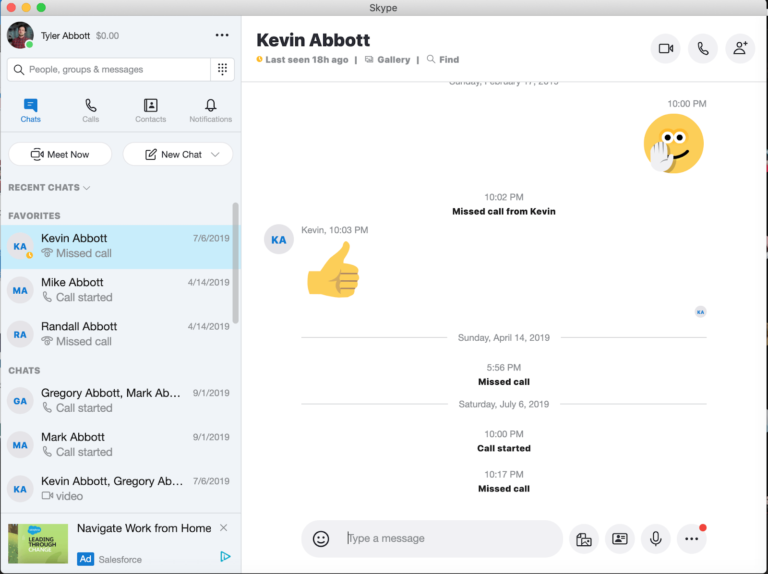
I use Skype to have long, usually Lakers-based conversations with my brothers.
The biggest downside with Skype is that it uses ads to keep its services free. So if you're not a fan of even small banner ads sitting around nonchalantly, you may want to look elsewhere.
Does anything cost money on Skype?
The only thing you’ll need to pay for on Skype is credit to make international phone calls. You can call phones and send text messages to folks abroad, like you would with a cell phone plan. Check out the rates for international phone calls here.
I always wonder how free things make money. What’s the catch? Skype really only makes money on selling Skype credit for calls directly to phones internationally and domestically, and it also sells ad space in the corner of the app (thankfully nothing very intrusive).
Google Meet: Best integration
- Syncs with your Google Drive
- Tons of recording space
- Specific to Gmail users
If your whole internet life revolves around your Gmail account (guilty), then Google Hangouts can make a lot of sense. You can easily start up Hangout sessions with your Google contacts without having to walk anybody through the process of downloading an app or creating an account. Honestly, half the battle of video conferencing is getting everyone set up (SNL captured this perfectly), and Google Hangouts can take that headache out of the equation. Emphasis on the word “can” in the previous sentence because if people don’t use Gmail, then Hangouts won’t work effectively.
Perhaps the coolest thing about the Google integration is that you can save recordings directly in your Google Drive. This gives you plenty of space to save recorded conversations and easily share them out with fellow Gmail users. If you already use Google programs for your daily life, then Google Hangouts makes a lot of sense as a Zoom alternative.
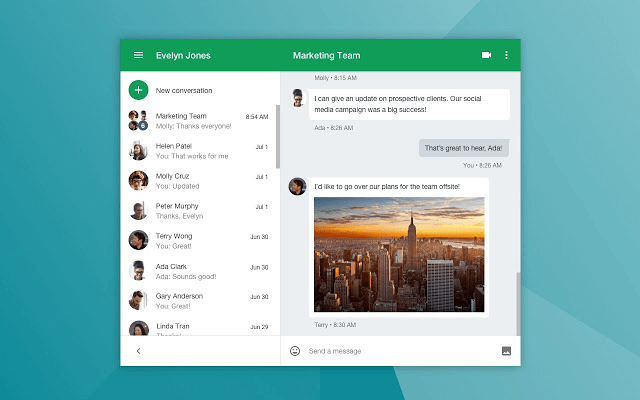
You can click the camera button while chatting with one of your Google contacts and start video conferencing.
Source: Google
Free conference calls limited to 60 minutes
If you only want to use the free version of Google Meet, your calls will cut off at the 60-minute mark. I honestly don't hate this rule because I hate every meeting that goes on for more than 60 minutes.
Microsoft Teams: Best bundle Zoom alternative
- Comes with suite of Microsoft programs
- Robust features
- Comes with Microsoft programs
You might think that repetition of "comes with Microsoft programs" is a mistake, but I assure you, it’s intentional.
Bundling Microsoft Teams with the other Microsoft Suite programs is either an awesome thing, or it’s something that will just go to waste. If you regularly use Microsoft Word, Powerpoint, Excel, and other Office programs over their Google counterparts, then getting Microsoft Team bundled with everything else is an amazing deal. If you won’t even use the Microsoft Suite of programs, then you could find better value with Zoom, Google Hangouts, or Skype.
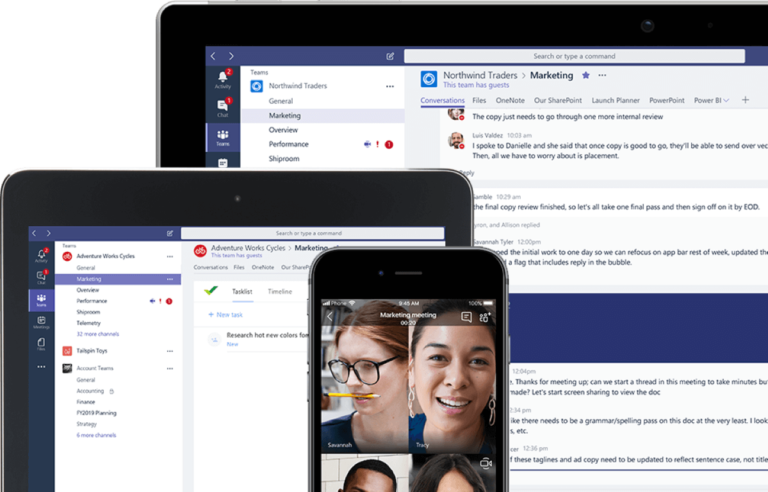
You can always get the free, stand-alone version of Microsoft Teams, but it doesn’t offer any recording storage, scheduling features, or security. Skype offers a lot more bang for your (figuratively speaking) buck.
If you decide to go with the paid version of Microsoft Team, you do get a lot of value out of the package. Along with the other Microsoft programs, you get 500 GB of storage space and in-depth scheduling features. All in all, the paid version of Microsoft Team is a robust Zoom alternative.
What’s the difference between the Business Basic and Business Standard plans?
The main difference between the two plans boils down to webinar hosting and desktop Microsoft apps. The Microsoft 365 Standard Business plan allows you to host webinars, complete with attendee registration and reporting tools to manage everything.
As opposed to the Business Basic plan where you only get the web and mobile versions of Microsoft 365 apps, the Business Standard plan gives you the downloadable desktop versions of those apps. Desktop versions of apps are basically always better, and more feature-rich than their mobile app counterparts, but perhaps the best part about desktop apps is that you don't need an internet connection to run them.
Zoho: Most accessible Zoom alternative
- Easy call-in features
- Webinar support
- Free plan doesn't offer meeting recordings
If you want to make the most accessible video conference or webinar, then Zoho is your best bet. Most video conferencing apps will expect participants to set up an account or download an app, but with Zoho, your meeting participants can just click a link on their computers or call in using their phones.
Imagine you wanted to organize a family conference call, but you know that grandma and grandpa probably couldn’t figure out how to set up a Zoom conference call. You can set up a Zoho conference call and just tell grandma and grandpa to click the link or enter the phone number you email to them. They can join in the call without having to download anything or create an account.
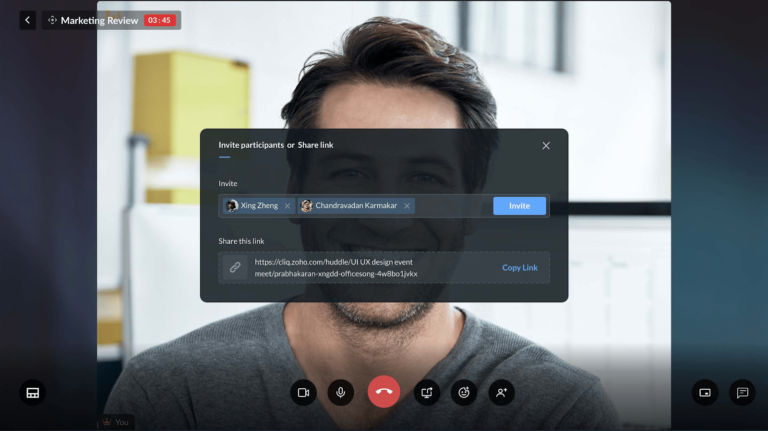
Zoho makes joining a conference call super easy. You can just send you a link.
Source: Zoho
Out of all the Zoom alternatives, Zoho is the easiest way to start up a video conference. And now that there's finally a free version, you can enjoy Zoho without forking over some cash. As long as you need to meet with a small group of two teammates plus you, that is.
Webinar features
Speaking of accessibility, Zoho has a built-in program for helping you set up a webinar series. These programs will cost you more than the $8 a month the Zoho Meeting package costs, but in theory, you could earn your money back with a successful webinar series. Zoho actually allows you to pay by the number of attendees you expect at your webinar. For example, if you only expect 1000 attendees, you can reduce the cost of the Webinar Standard plan to $75/organizer/month.
The webinar features include registration moderation, international dial-in numbers, and will even give you detailed reports about how people are engaging with your webinar. It basically takes all of the complicated out of hosting a webinar series.
Wire: Best secure Zoom alternative
- Advanced security features
- Affordable
- Max capacity
The most secure Zoom alternative that we could find is an up-and-coming software called Wire. Both of its plans are secured by end-to-end encryption, but its Enterprise plan offers a handful more security features.
Here are all the advanced security measures that Wire offers in its Enterprise plan to protect your conversations:
- SAML 2.0 integration
- SCIM provisioning integrations
- Wire API for services integrations
- Premium Support with SLA
For those of you who have no idea what those things are, rest assured they’re the latest in internet security. That’s why robotics labs, non-profits, and other technology companies like Intel use Wire for their Zoom alternative.

Wire looks similar to other Zoom alternatives, but there’s a lot happening behind the scenes to ensure maximum security.
Source: Medium
Wire has put all its eggs in the security basket so far, which explains the low low maximum video conferencing participants number. A few years ago, the max number of participants you could have in a video call was 12, so it's nice to see that Wire has upped that number to 50 participants at a time in a highly secured conference call.
For having so many security features, it’s pretty impressive that Wire only costs $5 or $9 a month. You’d think that it would cost double that for the amount of stuff you get. You just have to live with the small participant capacity.
Other free alternatives to Zoom
There are tons of other Zoom alternatives out there, beyond the four we recommend here. Let’s go through the honorable mention alternatives to Zoom lightning-round style.
- Slack: Slack has a built-in video conferencing capability and maxes out at 50 participants at a time. If you already use Slack, it’s super easy to make 1-on-1 calls.
- Discord: This communication software was made with gamers in mind, but it works as a free video conferencing platform as well. You can have 25 video conference participants at a time.
- FaceTime: If you're an Apple user, you're no doubt familiar with FaceTime. But did you know you can have a video call with up to 32 participants at a time? I didn't until recently. Turns out FaceTime can work perfectly well for smaller to mid-size teams.
- WhatsApp: As opposed to FaceTime, WhatsApp will work on both Android and Apple phones. You can have video conferences with up to 32 people at a time.
- GoToMeeting: GoToMeeting video conferencing has all the features you would expect from a top-of-the-line platform, and especially shines when it comes to hosting meetings from your phone. We just wish it was a few dollars less expensive.
- FreeConference: FreeConference does offer a free-tiered plan, but you only can get five participants at a time for video conferencing. There are paid plans that include more features, including a huge number of international call-in numbers.
Video conferencing depends on a reliable internet connection
Your video conferencing streaming quality will only be as good as your internet connection. To have a smooth stream with video conferencing, you want somewhere between 25 to 50 Mbps for download speed, with at least 1 Mbps for your upload speed.
But if you share your internet connection or like to watch Netflix while you keep your camera off and listen to your meeting, you'll need to look at 100 Mbps plans or thereabouts instead. (And we won't tell about the Netflix.)
If your well-made points constantly get reduced to static on video conferences, or if your stream tends to freeze you while making unflattering faces, you may want to upgrade your internet connection. We'll help you start your search by checking for internet plans in your zip code.
Recap: What are the best Zoom alternatives?
There are tons of Zoom alternatives out there, but we’ve narrowed it down to our five favorites of the bunch. Remember, just because everyone else is using Zoom these days, that doesn’t mean you should too.
- Best free Zoom alternative: Skype offers the most for the least amount of money. You can have up to 50 people on the same video conference call for free.
- Best integration Zoom alternative: Google Meet integrates beautifully with a Google account. You can conference with your contacts and save all of your conversations to your Google Drive.
- Best bundle Zoom alternative: Microsoft Teams. If you are a big fan of Microsoft programs, then bundling your video conferencing software with Microsoft can save you a lot of money.
- Best accessible Zoom alternative: Zoho is the easiest video conferencing platform for starting up a call. It’s super easy to send out a link or a phone number to invite participants.
- Best secure Zoom alternative: Wire specializes in end-to-end encryption and high security protocols for video conferencing. For our money, it’s the safest way to host a video conference.
Are we missing any of your favorite Zoom alternatives? Have you had any weird experiences on Zoom that made you want to ditch the platform? Let us know in the comments below.
Best Zoom Alternatives: FAQs
Skype underwent several significant changes and transitions over the years. Microsoft acquired Skype in 2011, and since then, the platform has evolved and integrated into various Microsoft services. Here are some key developments that happened to Skype:
- Integration with Microsoft Products: Microsoft integrated Skype into various products like Windows, Outlook, and Office 365, providing seamless communication capabilities within its ecosystem.
- Transition to Microsoft Teams: Microsoft's focus on enterprise communication and collaboration led to the development of Microsoft Teams, a comprehensive teamwork hub. Teams offered more robust features than Skype for Business and gradually became Microsoft's primary platform for online meetings, chat, file sharing, and collaboration.
- Rebranding: With the growth of Microsoft Teams, Skype for Business eventually got rebranded as "Microsoft Teams" for business users. This consolidation aimed to streamline Microsoft's communication offerings under a unified platform.
- Skype Consumer Version: The consumer version of Skype (regular Skype) continued to exist alongside Microsoft Teams, catering to personal use and individual communications.
- Changes in Features and Interface: Over the years, Skype underwent several changes in its user interface and introduced new features to stay competitive in the market, incorporating elements like real-time translation, call recording, and screen sharing.
The tl;dr version is that Skype has specialized as a free, consumer app best suited for casual conversations, and Microsoft Teams is the more business-friendly option.
Apple doesn't have a direct equivalent to Microsoft Teams, which is a comprehensive teamwork hub primarily designed for businesses and organizations. However, Apple offers several products and services that can be used for communication, collaboration, and teamwork, though they may not offer the same level of functionality and integration as Microsoft Teams.
- iMessage: iMessage is Apple's native messaging app for iOS and macOS devices. It allows users to send text messages, photos, videos, and more to other Apple users over Wi-Fi or cellular data.
- FaceTime: FaceTime is Apple's video and audio calling app, which enables users to make video and voice calls to other Apple users over Wi-Fi or cellular data. It supports group video calls with up to 32 people at a time.
- iCloud: Apple's cloud service, iCloud, provides storage for files, photos, and documents, making it easy to access and share content across Apple devices and with other iCloud users.
- Mail, Calendar, and Notes: Apple's built-in Mail, Calendar, and Notes apps offer basic productivity features for managing emails, scheduling events, and taking notes.
- iCloud Drive: iCloud Drive is Apple's file storage and synchronization service, allowing users to store files and access them from various Apple devices.
While these apps and services cater to individual users and provide some collaboration features, they are not as extensive or business-focused as Microsoft Teams. However, Apple continually updates and enhances its products and services, so it's possible that they may expand their offerings in the future to include more robust business collaboration tools.
Methodology
In pursuit of the ultimate video conferencing experience, we embarked on an investigative journey to identify the best alternatives to the ubiquitous Zoom platform. Our methodology involved a meticulous comparison of key features, including price, maximum meeting participants, cloud storage, meeting lengths, and other essential functionalities, to unearth the most promising video conferencing apps that could give Zoom a run for its money.
We considered six main factors in deciding the best alternatives to Zoom:
- Pricing: A thorough investigation of subscription plans and associated costs was undertaken to compare the affordability of each platform.
- Maximum Meeting Participants: We examined the platform's capability to handle a substantial number of participants in virtual meetings, ensuring it can accommodate various meeting sizes.
- Cloud Storage: The amount of cloud storage provided to users for file storage and video conference recordings was assessed to determine the platform's data handling capacity and ensure seamless access to essential resources.
- Meeting Length: We explored any limitations imposed on meeting durations to gauge the flexibility of each platform and to ensure it aligns with the requirements of different types of meetings.
- Security: The safety and protection of users' data and communications are paramount. We assessed each platform's security measures, including encryption protocols and compliance with industry standards, to ensure robust data protection.
- Other Features: Additional functionalities, such as integration with third-party applications, breakout rooms, live streaming options, virtual background support, and other unique features were thoroughly examined to identify the platform's versatility and ability to enhance the virtual meeting experience.
Related Articles





